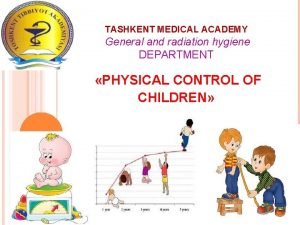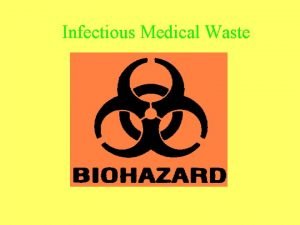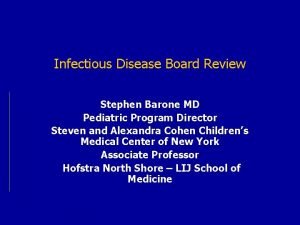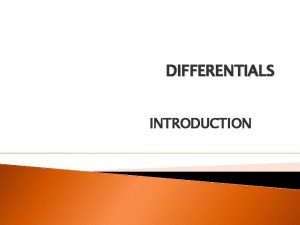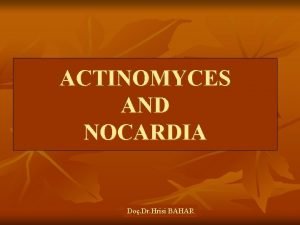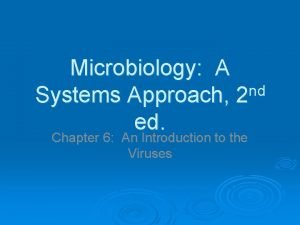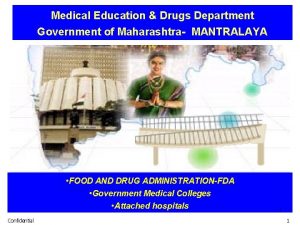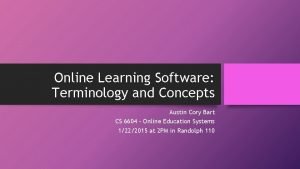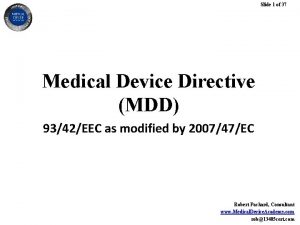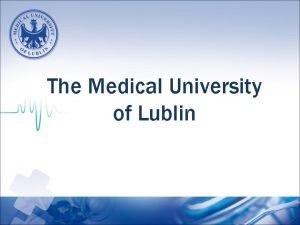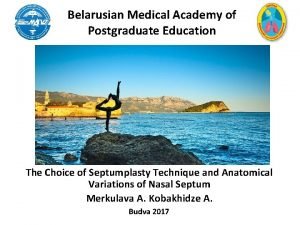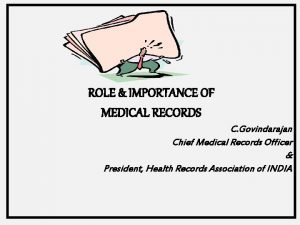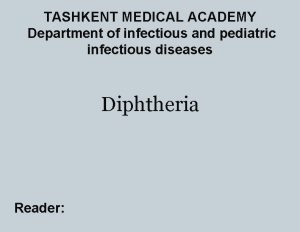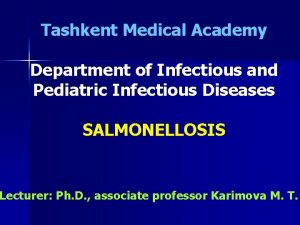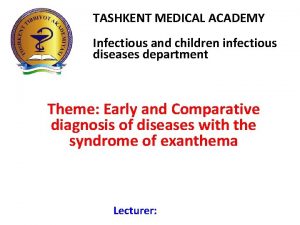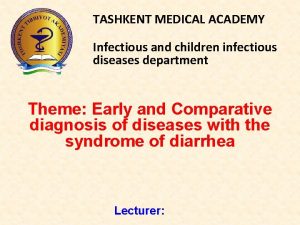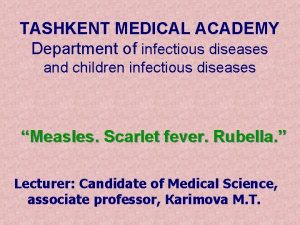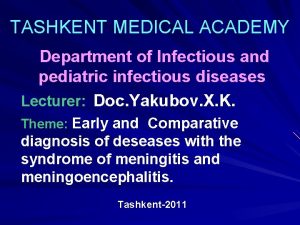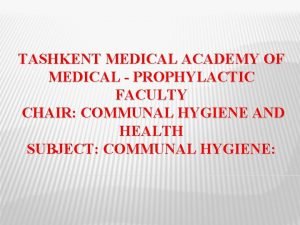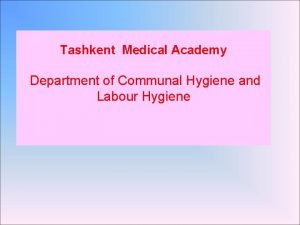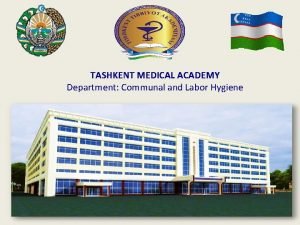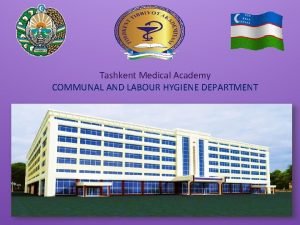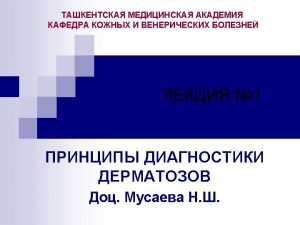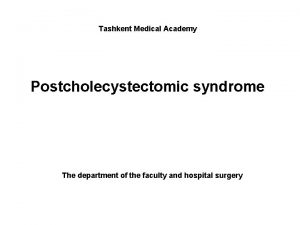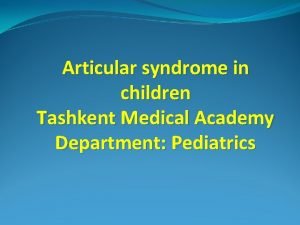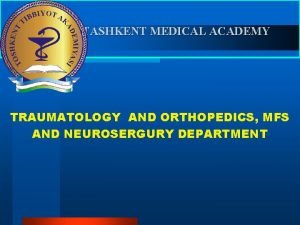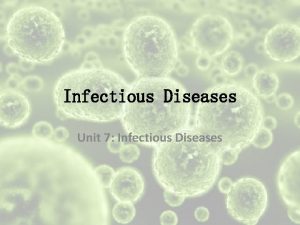TASHKENT MEDICAL ACADEMY Department of infectious and pediatric


























![DIFFERENTIAL DIAGNOSTICS n n n n Epidemic spotted fever, Brill's [Brill-Zinsser] disease; Typhoid (enteric) DIFFERENTIAL DIAGNOSTICS n n n n Epidemic spotted fever, Brill's [Brill-Zinsser] disease; Typhoid (enteric)](https://slidetodoc.com/presentation_image_h/0de90b528a35674611f03ffbaff1f876/image-27.jpg)





- Slides: 32

TASHKENT MEDICAL ACADEMY Department of infectious and pediatric infectious diseases Acute viral respiratory infections and influenza Reader: Candidate of Medical Science, associate professor, Niyazova T. A.

Counsel: 1. Introduction – 5 min. 2. Historical data – 5 min. 3. Etiology and epidemiology – 10 min. 4. Pathogenesis and pathological anatomy – 10 min. 5. Clinical findings – 30 min. 6. Diagnosis – 8 min. 7. Treatment measures – 10 min. 8. Preventive measures – 7 min. 9. Conclusion – 5 min.


INFLUENZA n Influenza, commonly referred to as the flu or grippe, is an acute, highly contagious infection of the respiratory tract, results from three different types of Myxovirus influenzae.

ETIOLOGY n n Pathogenic organism (agent) - RNA virus of the family Orthomyxoviridae, size of virus – 80 -120 nm; In virus classification influenza viruses are RNA viruses that make up three of the five genera of the family Orthomyxoviridae: Influenzavirus A, B, C; The type A viruses are the most virulent human pathogens and genetic changeable among the three influenza types; Changeability of virus is showed by changing of superficial antigens: - hemagglutinin (Н); - neuraminidase (N).

Viruses of influenza


Epidemiology n n n Large epidemics of influenza A arise in the range from 2 to 3 years, pandemics arise in the range from 10 to 15 years; Type B also strikes annually but causes epidemics only every 4 to 6 years; Type C is endemic and causes only sporadic cases; Source of infection is sick person, particularly at the height of the disease (4 -7 days of illness); Transmission of influenza occurs through of a respiratory droplet from an infected person or by indirect contact, such as the use of a contaminated drinking glass; Although influenza affects all age-groups, its incidence is highest in schoolchildren.

Known flu pandemics NAME OF PANDEMIC DATE Asiatic (Russian) 1889– 1890 Flu 1918 flu pandemic (Spanish flu) Asian Flu DEATHS 1 million CASE SUBTYPE FATALITY INVOLVED RATE possibly 0. 15% H 3 N 8 1918– 1920 20 to 100 million 2% H 1 N 1 1957– 1958 1 to 1. 5 million 0. 13% H 2 N 2 Hong Kong Flu 1968– 1969 0. 75 to 1 million <0. 1% H 3 N 2 2009 flu pandemic 2009– 2010 18, 000 0. 03% H 1 N 1

Epidemiology

Epidemiology

Pathogenesis (by Kethiladze Е. S. ) : n n n Reproduction of viruses in epithelial cells of mucous membrane of respiratory tract; Virusemia, toxic and toxic-allergic reaction of organism; Causing inflammation and desquamation; Bacterial complications of respiratory tract and other organs; Decrease of pathological process and change-over to recovery.

Pathogenesis


Symptoms of influenza n n n Symptoms of influenza can start quite suddenly one to two days after infection; Usually the first symptoms are chills or a chilly sensation, but fever is also common early in the infection, with body temperatures ranging from 38 -39 °C; Many people are so ill that they are confined to bed for several days, with aches and pains throughout their bodies, which are worse in their backs and legs.

Symptoms of influenza may include: n n n n Fever and extreme coldness (chills shivering, shaking (rigor)); Cough, nasal congestion; Body aches, especially joints and throat; Fatigue, headache; Irritated, watering eyes; Reddened eyes, skin (especially face), mouth, throat and nose; In children, gastrointestinal symptoms such as diarrhea and abdominal pain.


Clinical findings

Clinical findings

Clinical findings. Conjunctivitis.

Injections of vessels and enanthemas

Hemorrhagic pneumonia

Fibrinogenousnecrotic laryngotracheobronchitis

Segmental inflammation

COMPLICATIONS n n n Pneumonia; Rhinitis, pharyngitis, laryngitis, tracheobronchitis, locular and ва follicular quinsy, antritis, frontal sinusitis, ethmoiditis, otitis and others; Meningitides, meningo-encephalitis, arachnoiditis, polyneuritis, radiculitis.

DIAGNOSTICS 1. 2. 3. 4. Clinical findings; Viral investigations; Serologic investigations (RTGA, Reiter's complement fixation test, (R)CFT, RNGA); Immune-enzyme analysis.
![DIFFERENTIAL DIAGNOSTICS n n n n Epidemic spotted fever Brills BrillZinsser disease Typhoid enteric DIFFERENTIAL DIAGNOSTICS n n n n Epidemic spotted fever, Brill's [Brill-Zinsser] disease; Typhoid (enteric)](https://slidetodoc.com/presentation_image_h/0de90b528a35674611f03ffbaff1f876/image-27.jpg)
DIFFERENTIAL DIAGNOSTICS n n n n Epidemic spotted fever, Brill's [Brill-Zinsser] disease; Typhoid (enteric) fever and paratyphoid А , В; Meningococcal infectious; Tuberculosis meningitis; Aseptic [serous] meningitis; Tick-borne [vernal] encephalitis; Poliomyelitis; Infectious mononucleosis; Hepatitis А; Brucellosis; Q-fever; Ornithosis; Measles; Scarlet fever; Malaria.

TREATMENT n n n Regimen; Diet; Etiological treatment; Pathogenetic treatment; Symptomatic treatment.

ETIOLOGICAL TREATMENT n The two classes of antiviral drugs used against influenza are neuraminidase inhibitors and M 2 protein inhibitors: n Neuraminidase inhibitors – oseltamivir (trade name Tamiflu) and zanamivir (trade name Relenza); n M 2 inhibitors (adamantanes) amantadine and rimantadine.

PROPHYLAXIS n n n Isolation of sick (patient); Separate all plates and dishes used by sick (patient); Во время эпидемии гриппа запретить частое собрание многих людей в помещение; All people must wear gauze mask; Specific preventive measures (vaccination) should be carry out at the beginning of epidemic.

PROPHYLAXIS Type of influenza vaccine

Thank you for your attention!
 Tashkent medical academy fee structure
Tashkent medical academy fee structure Tashkent institute of textile and light industry
Tashkent institute of textile and light industry Tashkent university of information technologies
Tashkent university of information technologies Maro tashkent
Maro tashkent Chapter 26 infectious disease prevention and control
Chapter 26 infectious disease prevention and control Icd 10 morbus hansen
Icd 10 morbus hansen Hhps symbols
Hhps symbols Infectious waste management
Infectious waste management Infectious disease quality controls
Infectious disease quality controls Periods of infectious disease
Periods of infectious disease Stages of infectious disease
Stages of infectious disease Infectious canine hepatitis in dogs
Infectious canine hepatitis in dogs Stridor
Stridor What is the smallest infectious agent
What is the smallest infectious agent Infectious canine hepatitis in dogs
Infectious canine hepatitis in dogs Infectious nucleic acid
Infectious nucleic acid Infectious mononucleosis
Infectious mononucleosis Infectious disease
Infectious disease Ebv
Ebv Hennepin county infectious disease manual
Hennepin county infectious disease manual Epidemiological triad
Epidemiological triad Noncellular infectious protein particles are called
Noncellular infectious protein particles are called Infectious stunting syndrome
Infectious stunting syndrome Medical education and drugs department
Medical education and drugs department Khan cademy
Khan cademy Medical device academy
Medical device academy Medical academy of lublin
Medical academy of lublin Belarusian medical academy of postgraduate education
Belarusian medical academy of postgraduate education Academy of medical sciences multimorbidity
Academy of medical sciences multimorbidity Difference between medical report and medical certificate
Difference between medical report and medical certificate Role of medical records
Role of medical records Ptal california medical board
Ptal california medical board Gbmc infoweb
Gbmc infoweb
